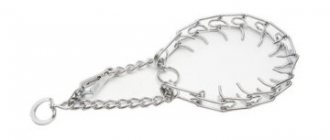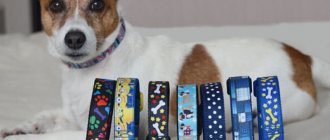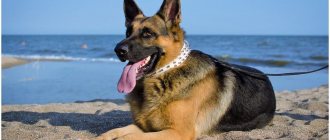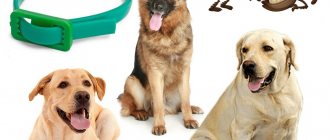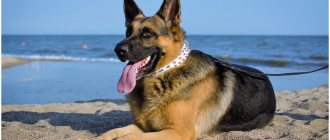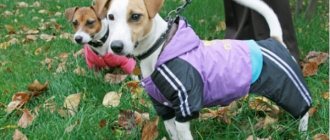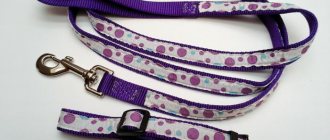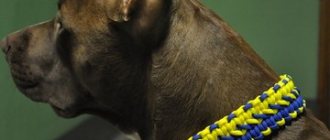At what age can you put a collar on a German Shepherd puppy? Choosing a collar for a German shepherd According to the rules for keeping dogs in the city, a collar for a shepherd is a mandatory attribute for going outside. The German Shepherd is included in the list of breeds
According to the rules for keeping dogs in the city, a collar for a shepherd is a mandatory attribute for going outside. The German Shepherd is on the list of breeds that are required to be walked only on a leash and are prohibited from being allowed out in public places.
Types of collars
Germans are characterized by increased activity, physical strength and often aggressiveness towards other animals. Therefore, choosing suitable ammunition is a responsible task. An inexperienced owner, faced with a huge assortment on the shelves of a pet store, gets lost and may choose an accessory that is absolutely useless for a given breed.
Collars for German Shepherd
Shepherd Collars for Daily Use
In order not to make a mistake, you need to clearly know what task this or that collar is intended for. Regardless of the type of collar, an address tag with the owner’s contact information should be attached to it.
Everyday
In appearance they resemble a wide belt. Suitable for both puppies' first walks and for walking and training adult dogs.
Everyday collars
For detection
LED collars (light-emitting diode) allow you to visually track a dog’s movements in the dark at a distance of about 500 meters.
LED collars
And GPS collars that display data about the dog’s movement on an electronic device (tablet, smartphone).
JPS collars
Antiparasitic
They protect your pet from flea and tick bites for several months. Based on the principle of action, they are divided into ultrasonic - repelling insects with signals indistinguishable to the human ear. And chemical ones - impregnated with repellents or insecticides.
Antiparasitic collar
Exhibition
To display shepherd dogs, unpainted metal chains with wide oblong links are used. They should not be too heavy or long so as not to hinder the animal’s movements in the ring.
Show collar
Too massive and bright chains visually shorten the neck and distract attention from the dog’s anatomy.
For training and behavior correction
If a dog has problems with obedience, then walking with a regular collar will become a real torment for the owner. To correct behavioral problems, you can use so-called training collars. Some of them are used only in classes with a dog handler.
Noose and martingale
When the shepherd begins to pull and tear from the leash, the noose squeezes the throat, cutting off the access of oxygen. When the tension is released, it opens to its normal position.
Martingale
For Germans, a jerk chain with large oblong links is suitable. Please note that metal garrotes can damage the animal's larynx. If your dog begins to wheeze when breathing, you need to switch to using a regular collar.
Noose
Spiked collar (parfors)
A strict collar for a German Shepherd is an indispensable tool in correcting behavioral problems. It will help you cope with ugly behavior during a walk - attacking dogs and other pets, pulling hard on the leash, picking up food from the ground. Another way to use it is in defense training, to enhance natural anger.
The collar consists of interconnected metal or plastic links with spikes directed towards the dog's skin. When pulled, the teeth compress the neck, causing severe pain.
Types of parfors for shepherds
For shepherd dogs, especially long-haired ones, plastic parfors are useless - thick hair prevents the thorns from reaching the skin.
Parfors is used only for punishment; you cannot take your dog out for a walk on it every day. Therefore, in addition to a strict one, the dog should also have a simple collar to which a leash is attached.
An inexperienced dog breeder can cause quite serious injuries to a dog with parforce:
- psychological (up to a nervous breakdown and outburst of aggression);
- physical (thorns leave puncture wounds that take a long time to heal due to the inconvenient location).
Therefore, training with the planer should be supervised by a dog handler.
An electric collar that sends vibration signals or mild electric shocks when unwanted behavior occurs. Needed to remotely influence the dog.
Shock collar
The specialist will select an effective correction method depending on the age and temperament of the shepherd. Please note: many dog handlers and dog breeders consider parforce and EShO to be overly traumatic.
Choosing a leash
When choosing a collar for a German Shepherd, a leash is also selected along with it. It is attached to a special ring, which is on the collar. Leashes are also divided depending on their purpose:
- A short product is necessary for training a puppy. Usually it does not exceed 2 meters in length. You need such a device to teach a young dog to walk next to its owner. It is usually made from synthetic materials.
- Long leashes are needed for everyday walks. Their length varies from 5 to 10 meters. These products are made from fabric tarpaulin. Sometimes they are equipped with a special locking device, which is necessary to adjust the length.
- Show leashes are designed to allow your pet to run alongside him while walking around the ring at a show. They are usually made in the form of a short and thin strap, which allows you to emphasize the elegance and dignity of the dog.
- Leashes-collars made in the form of a handle. Products are needed to take the animal from home to the place of walking, so that later it can walk on its own. It is used only for well-mannered shepherd dogs that can walk next to their owner.
- Tape leashes are usually made of plastic. Such ammunition allows you to control your pet. If the puppy runs too far, the owner simply presses a button located on the handle and the tape stops.
When choosing a leash, you also need to pay attention to the quality of the material. You should also select an accessory depending on convenience, purpose and comfort.
What is the best collar for a German Shepherd?
For a German Shepherd that does not have obedience problems, it is better to buy a simple walking collar. It is suitable for both walking and training.
Everyday equipment must meet the following requirements:
Strength
Best made from several layers of material. Do not dry or dye the wool. A nylon or biothane collar would be the best option.
Metal clasp
Plastic fasteners break very quickly.
The ring for attaching the leash must be strong. Otherwise, there is a risk that it will not withstand the force of the jerk, which is several times the weight of the dog.
The ring should be located at a distance from the buckle. This ensures even distribution of the load from the jerk.
Choosing a Collar
Before purchasing ammunition, be sure to measure your dog's neck. For a parfors, measurements are taken under the throat; for a noose, the widest part of the head is measured; for a regular collar, the middle of the neck is measured.
When choosing and trying on an accessory for walking, the owner should pay attention to the following points:
Size
There should be a distance of 1.5-2 cm between the collar and the neck, but no more. If the shepherd manages to wriggle out of a collar that is too large for it, the skill will be firmly established, even if the trick is successful only a few times. The dog will repeatedly make attempts to get rid of the interfering accessory. Correcting this behavior takes a long time, so try to find the right size right away. When the head is tilted, the collar or choke should not fly off the dog.
Product quality
Cheap ammunition breaks, cracks, gets wet from moisture, and the threads begin to rot.
Material of manufacture
It is better to opt for ammunition made from modern fabric materials rather than low-quality leather. They are more durable and have increased wear resistance. Most well-known companies that produce high-quality ammunition (Hunter, EzyDog, Ferplast, Kinologprofi, ROGZ) use textiles.
How to find out the size of a dog collar
Who hasn’t encountered owners who care about the material and appearance of their pet’s “harnesses”. But first you should think about how to determine the size of a dog collar, how long and wide it should be.
Start by finding out the volume of your pet's neck. To do this, use seamstress tape (it is also often called a tape measure). How can you find out your dog's collar size with this tape? Place the animal or make it sit motionless for a few seconds. Then grab the place where the dog usually has a collar. This place is called the base of the neck.
Of course, you need to take measurements, as they say, “including common sense.” The animal should not choke or experience discomfort from the harness, so do not press the sewing tape against the body. Don't let it dangle or droop. We need a golden mean.
How to properly put a collar on a German Shepherd?
Depending on the design, you can put a parfors on a dog in 2 ways:
- over the head. Care must be taken not to damage the dog's eyes;
- fasten at the neck.
The second option is much more convenient, but costs much more.
Parfors is fundamentally different from ordinary dog equipment. In order to achieve a sustainable educational effect, it is important to put it on the dog correctly:
- it should not hang loosely around the neck;
- it needs to be fastened at the base of the jaw and under the ears of the shepherd;
- the spikes should be in contact with the dog’s skin and fur;
- The design is adjustable using removable links. Depending on the girth of the animal’s neck, it needs to be reduced by removing several sections, or increased by adding a couple of plates.
At what age should you wear it?
You can wear a regular collar from the age when the puppy begins to be taken outside. This usually happens after vaccination quarantine, that is, at 3 months. Although training to use a collar should begin from the moment the puppy arrives in the house.
Using parfors to train a puppy under one year old is unacceptable.
When choosing equipment for your puppy, make sure that the collar is soft and can be adjusted in length. In the first months, puppies actively increase in size, and buying a new one every time is quite expensive.
A collar is not only a means of controlling a dog. To do this, you can successfully use a harness or halter. It also performs an aesthetic function - German Shepherds look especially impressive in multi-row metal chains.
No matter how convenient the equipment is, the dog should not be in it all the time. At home, it needs to be removed so that the fur does not roll and the skin does not rot. In addition, constant wear reduces the time you use the accessory.
Toys
Be responsible when choosing toys for your “German”. A large dog with strong jaws who also likes to chew on everything in sight will not be suitable for inflatable rubber toys or toys with squeaks. I personally knew a German Shepherd who literally chewed holes in the walls. For your home, you can buy classic KONG toys, which are a pyramid of three rings that are hollow inside. In addition to its main purpose (gnawing it all day long), you can put various treats in KONG or even freeze the toy in the refrigerator to “soothe” the gums of a teething puppy. These toys are resistant to chewing, and the treat inside will keep your pet occupied for a long time and your shoes will be safe. This is far from the only scenario for using KONG. Another bonus: the durable rubber toy massages your teeth and gums, which helps remove plaque from your teeth.
Zogoflex is another brand that makes chew-resistant toys. A special, especially durable series for particularly active chewing dogs is protected by a manufacturer's warranty. If your pet chews a toy, it will be exchanged for a new one absolutely free of charge (though only once). Zogoflex is a “dumbbell” (available in solid form or with the ability to put treats inside) or a specially designed ball.
Be sure to buy a toy for playing outdoors and while walking. The German Shepherd is a very active dog, and if you are not a professional athlete, you will get tired long before your pet has had enough of playing. A convenient and simple solution for dog games outside is PULLER . These are two rings made of elastic material: one you throw, the second in your hand. After the dog brings one ring, you take it away and at the same time throw in a new one. You can do other exercises with PULLER. Result: you are not tired during the walk, and the dog has poured out its energy into play and is not going to destroy the house or apartment.
Collars for German Shepherds
Your German Shepherd puppy is already four months old, all vaccinations have been completed, basic commands have been learned, and it’s time to fully get out into the fresh air. Do not forget about the most important thing - without a leash and collar, walking with your pet is simply impossible. On the street, the dog should always be supervised; these are the things that will help you keep the situation under control and continue training. In this article we will tell you what collars exist so that you can easily choose the right one for your pet at different stages of its life.
Is it possible to use a collar for puppies?
All dog handlers are clear on this – it’s impossible. Even if the puppy is a shepherd dog, Labrador, pit bull or another breed that requires careful attention from the owners. A strict collar is only worn on adult dogs.
Puppies can wear only these collars
A strict collar is a useful piece of equipment, but it is better to wear it under the supervision of a canine specialist. We must not forget that the main tools for training a dog are affection, attention and care, and punishment should be used only as a last resort.
Getting the puppy used to new clothes
Accustoming a breeding German puppy to a collar is not a difficult task. Before actually putting it on your pet, call your dog by name and immediately give him some kind of treat, along with words of praise, such as “Good” or “Well done.” Decide exactly how you will wear the collar.
It is put on in two ways:
- over the head;
- in the form of a belt.
For the first option, stick your hand inside the collar with something tasty, while the puppy eats with pleasure, carefully place the accessory around its neck. In the second case, while the baby is enjoying the treat, calmly bring the collar in the form of a belt and fasten it. The most important thing is not to tighten it so much that it does not compress the pet’s cervical vertebrae.
Ideally, the collar should be placed in such a way that there is enough space between it and the skin so that it does not cause discomfort to the dog, but at the same time the puppy cannot pull it over the ears. But do not forget that babies grow very quickly, so from time to time you need to check whether the accessory has begun to put pressure on him and loosen it if necessary. During all these manipulations, do not forget to talk to the puppy for a second, constantly praising him for his compliance.
Everything for a walk
If you live in a big city, you need to buy the accessories necessary for any walk. Unfortunately, nowadays cities are being built up so much that there is practically no space left for walking dogs, and you have to walk them where there is at least some space. Therefore, for a walk in any case, you will need a cleaning bag and a dustpan. Many dog owners in the city do not consider it necessary to clean up after their pet, which is a pity.
special boxes for cleaning bags on sale . They are usually attached to a leash, collar or tape measure. If you walk with your animal in crowded places, it is worth buying a muzzle for your dog, although this is not the most pleasant accessory for a shepherd dog. Or just walk away from crowded places. You also cannot do without a collar (or harness) and a leash (you can take a tape measure). Choose products that are strong and hold a breaking force that is at least twice the current weight of the pet.
German Shepherd Behavior
It is necessary to monitor the puppy's actions very carefully while he is wearing the collar. It is very good if the baby feels calm while continuing to do his business. For the first time, five minutes is enough, then you should remove the strap from your neck.
If you are dissatisfied, you should not immediately remove this accessory. Otherwise, you will make it clear to the puppy that this is an optional subject, which is completely undesirable for future education. Removing and immediately putting it back on, especially several times in a row, is strictly prohibited - you can scare the dog.
It is best to try to calm the baby during his fussy attempts to remove the uncomfortable object. Give him a treat, pat him on the back, while speaking kind words in a calm tone. Repeat these steps daily, and very quickly your puppy will get used to the collar.
Types of accessory
There are several types of collars:
- leather;
- metal;
- noose;
- electroshock;
- beacons;
- strict.
Let's talk in detail about each of them.
Leather
This ordinary soft accessory is perfect for long walks, and at the same time can be an excellent item for decorating a dog. This is the only collar suitable for puppies. For unforeseen situations in the future, you can attach a sign with the owner’s phone number to it. The German Shepherd is a large breed, you can buy a wide collar for it, but it would still be better to opt for a medium width. After all, they are not removed for a long time, and the larger the strap, the faster the hair underneath deteriorates and the condition of the skin worsens.
Choose wisely. The best option for this accessory is a buckle and ring welded together. You should not choose a strap with different decorations on it, for example, with metal spikes. You're not the only one who can get hurt during training. There is a risk of injury to other dogs when they play with your pet.
When choosing a collar for your shepherd, give preference to a durable belt with several layers of durable genuine leather. The purchased strap must be adjusted to the size of the neck so that the pet cannot jump out of it. If there are not enough holes in the strap, punch more in the place you need. It is best to secure the excess end of the strap with something. Otherwise, the dog will simply chew it off.
Metal
This type of strap consists of a metal chain. In some versions they come in several rows. Such an accessory exists, most likely, for beauty, during a hike, and not for walking and playing with other animals. They can break their teeth on metal. You should treat each other with respect and not use such collars in special areas during communication.
Noose
This type is designed in such a way that when you pull on the leash, it tightens. The part that does not tighten should be slightly smaller than the circumference of the neck. It is very convenient if you need to sharply hold a German Shepherd so that, for example, it does not run out of the apartment or rush at cats. After all, grabbing the withers is not only inconvenient, but can also cause pain to the dog. A noose is an indispensable thing during training and safe transportation of Germans.
Electroshock
To use a radio collar, you must consult with an experienced specialist. Only a certified trainer can explain the principle of operation. With the wrong approach, it is very easy to break a shepherd’s psyche, but it is almost impossible to restore it. When purchasing this accessory, always check the licensing certificate for the device. Based on the following indicators: power, range and the number of collars attached to one remote control.
Signal beacons
This type is used at night, especially if the color of your German Shepherd is too dark. Such collars are not used during particularly active games.
Strict
This type of training looks like an instrument of torture, but for a good owner, a strict collar is indispensable for such a large breed as the German Shepherd.
The strict collar is called a parfors and is made in the form of a noose. This type of strict strap during training increases the impact on the shepherd. If you have absolutely no experience using a strict collar, be sure to consult a specialist for advice, and do not use the parforce on a daily basis.
Due to your dog's lack of knowledge, wearing this accessory all the time will become addictive. But if your pet is happy to wear a strict collar, then you can sometimes put it on before walks. A strict collar is made of spikes connected together. It is necessary to choose the right volume of parforce, otherwise you may injure the shepherd’s neck.
Whatever collar you choose for your dog, take care not only of your comfort. A German Shepherd should feel comfortable wearing any accessory. It should not bring her discomfort or pain. For walking or training, use collars suitable for these activities: leather, noose, strict. If you have any doubts, always consult with specialists.
Did you like the article? What collars do you use for your dog?
Types of Collars
Dog collars differ primarily in the material they are made of:
- Leather is a classic of the genre. The cost depends on the quality of the material. Expensive products made from genuine leather are beautiful, reliable, and last a long time. Cheap straps stretch quickly and become cracked when subjected to strong tension. It is not advisable to swim in a leather collar or leave the product in the sun. The strap should be periodically cleaned or oiled.
- A canvas collar is cheap, but is considered reliable. It is not advisable to wet the material - it becomes too heavy, and if it is not dried well, it rots. After prolonged wear and frequent cleaning, the tarpaulin becomes shaggy and brittle. If the tension is too high, the belt may break.
- Ammunition made of nylon and nylon is considered durable and reliable. The price of such products is quite high. Disadvantages: there are snags on the material and the collar can easily come undone.
- A metal chain is a reliable product, but it rusts when in contact with water and can stain light wool or tear out hairs with a certain type of weaving.
Soft straps are the most comfortable type. They are made from natural and eco-leather, equipped with a lining made of soft fabric (felt, fleece) or thin leather.
This category includes types of products by purpose:
- everyday with a half ring for a leash;
- products for protective training with a handle for holding the dog;
- guard strap with a half-ring for the belt, redistributing the load from the buckle.
Reference.
Collars made of artificial materials are suitable for daily walking. They are durable and do not irritate the skin.
Strict straps are designed to train the animal. Unlike soft straps, they do not provide comfort, but on the contrary, cause pain to the dog if it breaks discipline. A strict collar is used for educational purposes. When a puppy behaves inappropriately, the mother bites its neck with her teeth. A collar of this type “behaves” the same way. Maintaining discipline is part of a dog's nature.
Types of strict collars:
- Parfors with spikes from the inside causes discomfort when stretched. The shape of the spikes can be different - lamellar, wire. The first option is suitable for short-haired breeds.
- The noose is tightened around the neck like a noose. The product is designed to pull dogs away from passers-by, other dogs, and suspicious objects.
- A shock collar delivers a small shock of current through a signal. The pet feels a slight tingling sensation, but does not suspect that the owner is to blame.
- Antilay calms down overly scandalous individuals. The collar emits an ultrasonic signal in response to barking. Only the dog can hear it. The signal intensifies as the dog’s passions heat up and has a depressing effect on the animal.
Such devices are not recommended for frequent use; they are also not suitable for pocket dogs, but are intended exclusively for large and fighting breeds.
Products with special functions:
- The GPS sensor allows you to let your dog roam freely in the forest or in the country. The dog will not get lost, because the owner knows where his pet is.
- LEDs allow you to walk your dog at night. Passing motorists will see if an animal jumps onto the road.
- Antiparasitic substances help protect the animal from fleas, ticks, midges, and horse flies.
- Decorations on straps (rhinestones, figures, stickers, spikes) are more likely a whim of the owner than a necessity. Such collars are often purchased by owners of decorative breeds.
- A medallion with information is a useful thing. On it you can indicate the dog's name, the owner's phone number, and vaccination information.
Some breeds are not suitable for regular collars due to their body structure. For example, greyhounds have a weak neck, and a classic strap can only do harm. Greyhounds with soft expansion were created for them. Those with long hair will appreciate rope-shaped products with an external side seam. Such collars do not tangle or tear out hairs.
Why is it important
During walks, the owner must fully control his pet: the dog may run out onto the roadway, encounter aggressive animals, or be frightened by loud sounds and run away. In addition, representatives of large breeds can cause inconvenience to the people around them; walking them without a muzzle and a leash will result in a fine.
An untrained dog may react aggressively to new accessories: the collar will cause discomfort on the neck at first, and the leash will make it impossible to go wherever it wants, so you need to gradually accustom dogs to a leash.
At what age should I start?
You can teach a dog to walk “correctly” at any age, however, the younger the dog, the easier it is to train. Dog trainers advise puppies to be accustomed to a leash from 3 months, and to a collar no later than 8 weeks.
When the puppies are 7–10 days old, breeders, in order to distinguish the babies, mark them with multi-colored ribbons: this is how the dog gets used to new sensations on the neck from childhood. By two months, the bandage can be changed to a light collar.
You can take your pet outside only after vaccination, which is carried out at 2.5-3 months. They begin to fasten the leash from the second or third walk: the puppy needs time to get used to the new environment, smells and external stimuli, so the first walk is for the purpose of getting to know each other, not training.
How to choose an accessory
Ammunition should be selected based on the size and breed of the animal. Small dogs need accessories made from thin, lightweight materials, while large dogs need accessories made from tougher ones.
If the puppy has long hair, then the collar and leash should be smooth so that the hair does not pull out. Options with chains or spikes are not suitable for children: they are too rough and heavy.
The collar will always be in contact with the pet’s neck, so you need to choose it responsibly.
- In the first 2-3 months, when you are just starting to accustom your puppy to a collar, choose products made of nylon material with plastic fasteners: they are practically not felt on the neck.
- Babies grow quickly, so it is more profitable to take an adjustable collar, but make sure that the remaining edge does not stick out too much and does not interfere with the pet.
- Do not tighten the accessory too tightly. Two fingers should fit freely between the collar and neck.
- When the puppy gets used to the “baby” collar, replace it with a product made of canvas or synthetics. There is no need to use rough, low-quality leather or leatherette: over time, this material will become rough and crack, which will cause discomfort in the dog.
- The most comfortable collar design is European. The clasp is located at the bottom, and the ring for the leash is on the side: this prevents hair from being pulled out and does not allow the animal to shake its head during walks.
- To prevent the collar from rubbing your pet's neck, choose a product with a soft fleece or felt lining.
With the help of a leash, the owner will control the puppy on the street, so the product should be comfortable for both the animal and the owner:
- choose models made of nylon or canvas: they are light, but at the same time quite strong;
- the ideal leash length is 1.5-2 meters;
- the clasp must be securely attached to the collar so that the puppy does not fall off the leash;
- give up tape measures: they make it more difficult to control the animal;
- a leash in the form of a metal chain is inconvenient to hold and wrap around your hand, and such an accessory will be too heavy for a puppy.
Do not buy thin harnesses: the dog may jerk sharply and damage the fragile chest. As an alternative, you can consider vest harnesses: they apply soft, even pressure.
How to choose a harness
Before choosing a harness for your pet, you need to study what it can be made of and how to choose it correctly. Below we will consider the varieties of this device.
Tarpaulin
Canvas harnesses are quite inexpensive products. They are suitable for infrequent walks with a young puppy. It is unlikely that such fabric devices will last long if the dog is already an adult and quite active. In addition, material such as tarpaulin deteriorates when exposed to moisture and is very difficult to wash.
Synthetics
Products made from synthetic materials are very practical and versatile. They combine the qualities of all other materials: they do not stretch, tear or get wet. In addition, they are easy and simple to care for. Synthetic ammunition is suitable for any purpose of use, from ordinary walks to education and training.
Leather
Accessories made from genuine leather are the most expensive in their price segment. This is very justified. After all, they look noble and beautiful on a dog. But skin tends to stretch when exposed to moisture. Therefore, it is better to use such devices at an indoor exhibition.
Before choosing a harness, you need to pay attention to the ring, fastening and clasp. They must be made of metal so that such a powerful animal as a German Shepherd does not break off the leash.
Principles of training a puppy
The puppy can get used to the new equipment in a few days, provided that it does not cause any discomfort to the baby. In order for the dog to get used to it faster, owners need to learn the rules for teaching a puppy to use walking accessories:
- training should be gradual: first let the dog get used to the collar, then fasten the leash;
- As soon as you put the product on your pet, praise him or treat him with a treat;
- do not hit the dog with walking items and do not let it play with them: the dog must be neutral towards the equipment;
- first put on accessories for 15–20 minutes, then gradually increase the time to several hours;
- before you start teaching your puppy to walk on a leash, let him burn off excess energy - play or run with your pet;
- The first exercises are best done at home, and when the dog gets used to it, you can go for full walks;
- If during training the puppy starts to run in the wrong direction, take the baby in your arms or distract him with a toy, but do not pull or jerk him.
If you follow these recommendations, your pet will quickly get used to new things, however, teaching him to walk on a leash next to his owner will take more time: from one week to a month.
Features: how to maintain?
Depending on where the pet will be for most of the day, conditions for its maintenance are created. City apartments and country houses have their own rules, but there are also general rules for housing a dog.
In a city apartment
Large service breed dogs are kept in both small-sized apartments and large-area housing. Of course, the second option is preferable. But apartments with small rooms are quite suitable for keeping shepherd dogs. Considering that an adult dog sleeps on its bedding most of the day, its presence will not embarrass the residents. The main thing is to determine places for sleeping and feeding at home :
- choose a place for the mattress where the pet will not disturb anyone and will not be disturbed while resting;
- Do not place the bed in a draft or near a central heating radiator.
A bowl of water should be constantly available, but installed so that residents do not bump into it, for example in a corner. Use special stands where bowls are placed . The stands are adjustable in height, which is very convenient for the dog.
It is mandatory to walk an adult dog at least twice a day, regardless of the weather. For a puppy - more, and the younger the puppy, the more often he is walked. You need to be prepared for the fact that a dog, especially a young one and not properly trained, can chew furniture, shoes and other things.
And, of course, do not forget that German Shepherds shed twice a year or more . Daily cleaning of the apartment will become a chore, otherwise there will be wool not only on the floor, but also on the furniture, clothes and in the air.
Important! Apartment keeping of such large breeds of dogs as a shepherd can bring some inconvenience to the life of not only the owners, but also the animal, so it is extremely important to approach the issue of allocating space for the pet and organizing the entire space as rationally as possible.
In a private house
If it is expected that the dog will stay in the house most of the day and go out for walks when necessary, the same conditions are created for it as in the apartment. The advantage of country life is the ability to let your dog out into the yard at any time. A prerequisite is the presence of a strong fence around the local area, beyond which the dog cannot go.
An aviary in the yard and a warm booth will increase the pet’s comfort . During the day, the dog, while in the yard, will be able to hide from both bad weather and prying eyes. The presence of a kennel does not exclude the possibility that the owners will take the pet into the house at night.
Free range also has its disadvantages, especially if there are flower beds and beds in the yard. It is possible that the dog may damage the plantings. Therefore, you need to either fence off areas where the dog is not allowed to be, or designate a walking area for the dog.
Attention : regardless of whether the dog is constantly in the local area or is walked periodically, there must be a warning sign on the gate: “There is a service dog in the yard.”
On the street
The presence of a suburban area allows the dog to be placed in the yard:
- Free range with accommodation in a kennel. Allowed if the dog cannot leave the site.
- In a booth on a chain. Not a desirable option. Dog handlers cannot yet come to a common opinion on the possibility of keeping a German Shepherd on a chain, but most specialists, and even owners of “Germans,” have a negative attitude towards keeping a German shepherd on a chain.
- Staying in an enclosure equipped with a booth.
German Shepherds are quite capable of living outside, especially if they have been trained to do so from puppyhood. The thick undercoat prevents the dog from freezing, and constant exposure to fresh air will only improve the health of the animal .
Outdoors in winter
It is permissible to keep a German Shepherd outdoors all year round. Naturally, it is impossible to transfer an adult dog raised in an apartment to the cold immediately, since it needs a long period of adaptation to the cold.
For a dog raised outside the city and accustomed to being outside the home for a long time, a complete transfer to street keeping is acceptable. To prevent the pet from freezing, they equip him with an indoor enclosure and install an insulated booth. A spacious enclosure will give the shepherd enough freedom for active movement .
Winter is a time when you need to take extra care of a pet living outside. Despite the fact that an animal can eat snow to quench its thirst, you need to change the water in the bowl on time if it is frozen. The food is served warm enough so that the dog has time to eat the food before it gets too cold. If the thermometer drops too low, check to see if the dog is cold.
Reference! If it is known in advance that the German Shepherd will live outside in the winter, it is recommended to purchase a puppy that was born and spent the first weeks of its life in an enclosure. Such individuals have strong immunity and a short period of adaptation to life in the open air.
Can you keep it on a chain?
Theoretically, any service dog can be trained to be chained . This is convenient for the owners. The chain is fastened to the booth or on a movable block to the cable. But both cynologists and the owners themselves mostly express negative opinions about such restrictions on the freedom of German shepherds.
Psychological factor
Perceiving the leash as a betrayal towards itself, the animal begins to show excessive aggression. An unchained dog sometimes becomes uncontrollable. The anger of the chained shepherd becomes uncontrollable, and the animal begins to pose a danger to humans.
Physical discomfort
Constantly being on a chain is a severe limitation of movement . The dog suffers significant physical harm:
- sagging back;
- limb weakness.
There is a danger that the animal will become entangled in the tether. At best, this will lead to the dog not being able to reach bowls of water and food; at worst, asphyxia will occur if the chain gets wrapped around the neck.
From the point of view of security functions, it is easier for attackers to resist a shepherd if it is on a leash .
For reference : you can leave a German Shepherd on a chain only for a short time, when it is necessary for the sake of safety, for example, if the yard is visited by people unfamiliar to the animal.
Why does a dog eat its own excrement?
It is quite common for dogs to exhibit coprophagia, or eating their own excrement. There are prerequisites for this:
- Physiological:
- bitches cleaning up after their puppies is a manifestation of atavism: when animals are in the wild, such behavior contributes to the safety of the offspring;
- puppies learn from their mothers and begin to eat feces in the same way, continuing to do so as they grow up.
- Acquired as a result of an inadequate diet:
- lack of digestive enzymes;
- little protein in food;
- lack of vitamins B, K, minerals;
- general food shortage.
It may also be that the owner, in the process of raising the puppy, punished it too harshly for “big things” at home. The pet, possessing natural intelligence, will quickly realize that “hiding” the traces of a “crime” in this way means protecting itself from punishment. Later, this behavior simply becomes a habit.
Possible solutions to the problem
- Contacting a veterinary clinic to identify health problems associated with an incorrect diet. Changing your diet.
- More frequent walking if the dog cannot tolerate it and defecates at home, and then eats the excrement in order to hide the marks.
- Use of prohibiting commands and reward systems.
- Treating feces with pepper or special products sold in veterinary pharmacies.
How to train an adult dog
If you did not pay enough attention to raising a dog as a child or acquired an adult animal, you will need a lot of strength and patience to re-educate your four-legged friend. Training in such cases takes several months.
Try to make sure that the collar and leash evoke only positive emotions in the animal: when putting on walking accessories, praise the pet and play with it. If your dog refuses to wear the equipment, try putting it on before eating: the dog will first of all pay attention to the bowl of food, and unusual accessories will not bother him.
As soon as the animal gets used to the new sensations, take it outside. Choose deserted places so that your pet is not distracted.
Give the command “near” and entice the dog with a treat. Keep the treat next to your left leg, making sure your dog doesn't run ahead or get under your feet. After a few “correct” steps, praise your pet and give him a treat.
Training should be done daily for 20-30 minutes, gradually replacing treats with verbal praise.
Rules for first acquaintance
New items should not have any foreign odors. Take them out of the packaging and leave them in the apartment for several days. Experienced breeders advise rubbing the accessories with the puppy's brushed hair so that the dog can catch a familiar smell.
Before putting the collar on, let your puppy smell it. Fasten the accessory and give your dog a treat.
Accustoming should be gradual, so in the first days the collar is put on for 15–20 minutes. Once the dog gets comfortable, you can attach the leash. The puppy should run around the house with it and not pay attention to it. If your baby starts playing with the equipment, distract him with other toys.
Home workouts
As soon as the puppy gets used to new things, you can begin the first training. They should be carried out at home so that the dog is not distracted by anything. The first lesson should take no more than 5 minutes: the shorter the exercises, the faster they will give positive results. Over the course of a week, gradually increase the training time to 20 minutes, however, do not overtire the animal so as not to cause a negative reaction in it.
Loyal method
This approach allows you to maintain a trusting relationship between pet and owner. The dog will associate the leash and collar with pleasant memories, and he will be happy to go for walks.
- Call your puppy's name and attach the leash.
- Give the command “near” and start walking forward slowly.
- As soon as the dog starts to run away from you, stop.
- The puppy will feel an unpleasant pressure on his neck and will understand that he is more comfortable next to his owner.
- Wait until the dog pays attention to you, call him and give him a treat.
- Continue in the other direction.
Training doesn't have to be boring. For the first time, 5-10 steps will be enough. Over time, treats need to be replaced with praise. Ideally, there should be three verbal affirmations per treat.
Hard approach
Training on this principle takes much less time, however, the dog may develop a hatred of walking accessories and walks in general. In addition, if you do not calculate the force, you can injure the animal. The essence of the method is to sharply pull the leash as soon as the pet begins to move away from you. It is important that the jerk is sharp, but not strong: the puppy should be scared and feel discomfort, and not be injured. In this way, the dog will quickly understand that it is impossible to run away from the owner.
Harness at home
It is quite possible to make a walking accessory for a shepherd dog yourself. Any material is suitable, the main thing is that it is durable and wear-resistant. Nylon slings (tapes) are most often used. This material is lighter than leather or leatherette, but much stronger and more durable.
When sewing, the size of the dog is taken into account (the measurements that need to be taken are described above). Moreover, you can sew products for a growing dog yourself. For example, make straps with rings to adjust the length. This harness will come in handy when purchasing a shepherd puppy.
After constructing the patterns, you need to leave seam allowances. For nylon, usually add no more than 2 cm, for natural material - 0.5 cm. Using the finished pattern, a lining is made of a soft material, such as insulation. The parts should be sewn from the front side. Then the straps are additionally stitched. The rings are attached to the back area.
A handmade accessory can even be decorated with rhinestones, beads or crystals. The main thing is to consider not only your taste and desire, but also the convenience for the dog. Jewelry must be safe. If you can’t make ammunition for your beloved pet with your own hands, then you can resort to the help of professional tailors.
The role of tasty rewards
During training, the dog must be praised for correct actions: it will quickly understand what they are trying to achieve from it. Verbal approval should be reinforced with treats, as tasty food greatly motivates animals. When using delicacies as rewards, follow these tips:
- the treat should be small and low in calories;
- It is desirable that the reward is not only tasty, but also healthy - you can take vegetables or special dog treats;
- the treat should only be given if the dog has followed the command perfectly;
- choose products not from “household” food: this way the dog will consider such a reward special;
- "tasty rewards" are especially effective when the puppy is a little hungry.
Don't forget to alternate delicacies so that your pet doesn't get tired of the monotony. It is enough to find 2-3 favorite treats and change them periodically.
Rules of conduct for the owner during training
The success of training depends primarily on how the owner behaves during training. To achieve good results, you need to follow certain rules.
- Ensure that your instructions are followed - this will show your pet that you are a leader.
- Don't raise your voice. Commands must be given clearly and calmly.
- Train every day, but at different times.
- Do not hit your dog for disobedience: this approach will cause negative associations in the puppy. You can demonstrate disapproval by using a stern tone.
- Praise your puppy generously for following commands correctly.
The more patience and understanding you show, the faster your dog will learn new skills.
How to properly care?
Caring for a German Shepherd involves different activities.
Hygiene:
- combing;
- bathing;
- nail trimming;
- ear cleaning.
Mandatory visits to the veterinary clinic for periodic examinations and vaccinations ensure that the animal avoids diseases.
Regular long walks at least twice a day for an adult dog and more frequent for puppies and adolescents will ensure the physical strength and mental health of the pet.
Training is an obligatory stage in keeping a German Shepherd : a visit to the site and classes with an instructor is recommended, but raising the puppy independently is also allowed if the owner already has the appropriate skills and experience in handling serious service breeds.
A well-mannered, well-groomed dog will never cause problems for its owner. But in order for the German Shepherd to be obedient and healthy, the owner will have to put in a lot of effort and be patient. And then a harmonious tandem of man and dog will form, and life will be filled with mutual love and trust, devotion on the part of the pet and adoration for the four-legged friend on the part of the owner.
Basic mistakes
If your puppy is constantly playing around, getting distracted, and not listening to you, then you may have made the following mistakes.
- They were allowed to play with a leash. Now the dog treats him like a toy and doesn’t take him seriously. In this case, it is better to buy a new accessory.
- They hit or waved the leash. This makes the puppy afraid or hostile towards him. In this situation, the leash also needs to be changed.
- They pulled the leash when the pet walked in the other direction. Over time, the dog got used to the pressure on his neck and for him it became a normal sensation.
- They shouted and scolded the animal during training. The dog began to perceive walks and training with fear. Smoothly change tactics, making it clear to the puppy that you will not offend him.
- They were loyal to pampering. The puppy sensed your weakness and is now trying to take on the role of leader. To change the situation, start stopping any disobedience.
- The training dragged on for several hours. Monotonous exercise tires dogs. Reduce your workout time to 20 minutes.
- We used a roulette leash. The dog is used to the feeling of tension. Replace with a regular leash.
- They chose the wrong collar size or tightened it too tightly, so the dog was constantly experiencing discomfort. Loosen or replace the accessory.
Most errors can be easily corrected. Work through them, and your pet will happily start walking on a leash, unconditionally following all your commands.
Main functions
A dog groomer performs two functions: it corrects behavior and teaches commands. In any case, wearing it should be combined with voice commands and careful observation of the animal’s behavior. You can use the product while walking or during training with a dog handler.
During a walk, the planer is used to suppress the animal’s aggression and develop the habit of obedience to the owner. The main task is to prevent attempts to pull on the leash. A dog walking in a parforce will feel comfortable only when it calmly walks next to the owner or runs away to the permitted length of the leash.
If a dog exhibits inappropriate behavior - barks at passers-by, tries to run away and drag a person along with it, the collar immediately causes him discomfort.
In this case, the owner should not passively observe how the dog behaves. By his actions, he must indicate the inadmissibility of her behavior - say “no”, pull the leash towards himself. If the owner understands his animal's behavior well, he can give such signals in advance. As a result, the pet learns to obey. Important! In packs of dogs, a bite on the neck is a kind of punishment from individuals occupying a higher position.
For the animal, this is a signal that its behavior is not approved by a stronger animal, and it needs to be stopped. The pressure of the planer's spines on the neck imitates such a bite. If a dog collar is needed to teach the animal certain commands, then it is worn only during training. The owner holds the leash, gives a command, and if the dog does not comply, he pulls it towards himself. An important component is that the owner must make the animal understand what he wants from him, and only then apply strict measures. The effect is the same as in the case of a walk. A dog is comfortable only when it obeys, and uncomfortable when it disobeys.
The main thing that the owner needs to understand before using such equipment is that a strict collar for a dog is a temporary solution. He develops the habit of obeying, but the owner himself must maintain it. That is, the goal of training is to motivate the dog to obey, regardless of whether he is wearing a handler, a regular collar, or no equipment at all.
And this collar is decorative
